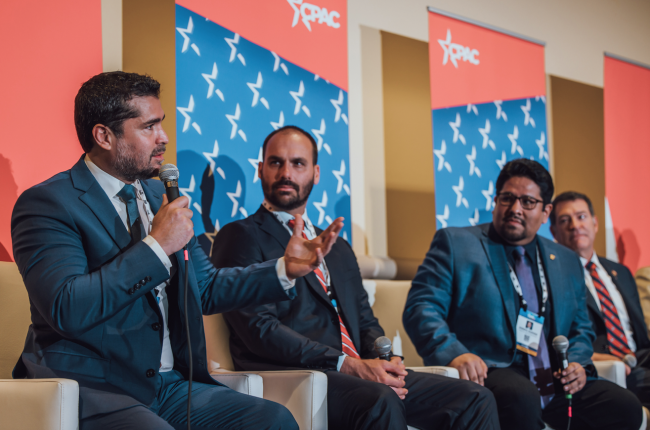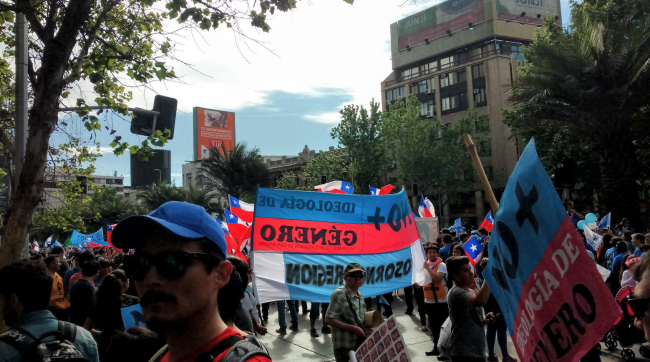
This piece appeared in the Spring 2024 issue of NACLA's quarterly print magazine, the NACLA Report. Subscribe in print today!
Leer este artículo en español.
The victory of Javier Milei in Argentina’s presidential elections last November exploded a veritable atomic bomb, whose shockwaves reach far beyond the Latin American country. The paleolibertarian economist, known for his crude insults against “lefties,” immediately received congratulations from the members of what the Spanish philosopher and politician Clara Ramas has called the new Reactionary International. Although they have never brandished chainsaws at their rallies, for Donald Trump, Jair Bolsonaro, Viktor Orbán, Giorgia Meloni, José Antonio Kast, and Santiago Abascal, Milei is one of their own.
The arrival of Milei and his La Libertad Avanza party to the Casa Rosada is just the latest example of a process that has been developing over at least three decades and that has accelerated in the wake of the 2008 economic crisis. Currently, in addition to Argentina, the extreme right governs in four European countries (Italy, Hungary, Finland, and the Czech Republic), externally supports a conservative executive in Sweden, and could soon reach the government in the Netherlands, after the success of Geert Wilders in the November elections. As is known, the far right also ruled in Poland for two terms and in Brazil and the United States for one. In 2024, elections could propel far-right formations into governments in Portugal and Austria, not to mention the political earthquake that would come with electoral gains for the far right in the European Parliament elections in June and, above all, in the United States in November, with the possible return of Trump to the White House.

In short, as the Dutch political scientist Cas Mudde has pointed out, these political forces have become demarginalized. That is, on the one hand, they have become relevant political actors and accessed the government in various countries. On the other hand, their ideas have become normalized, shaping political agendas while being shared within conventional spaces. The radicalization of mainstream right-wing parties is reliable proof of this shift, as is the extreme right’s “conquest of the streets,” which has even included violence against political institutions or party headquarters in the United States, Brazil, and Spain.
In this early 21st century, a new spectre haunts the world. It is not the spectre of communism, as Karl Marx and Friedrich Engels explained in the mid-19th century, but the spectre of the extreme right. Although there are still no leading intellectuals nor a manifesto of a worldwide far-right party, this does not mean that it is not a globally organized, albeit heterogeneous, political force. On both sides of the Atlantic, recent events clearly show this is the case.
Fascist, Populist, or Radical Right?
The rise of these political formations has led to a whole series of public and academic debates. The first is related to the definition of this phenomenon. It is often said that fascism has returned. In this regard, the thesis of eternal fascism or Ur-Fascism put forward by the Italian intellectual Umberto Eco has notably circulated in recent years. According to Eco, the creation of a “fascist nebula” requires the presence of only one of the 14 characteristics he detailed in his essay, among which are the cult of tradition, fear of the other, or the appeal to frustrated middle classes. Is this true? The question is not trivial, because the ability to define a political phenomenon is the first essential step to being able to understand and, by extension, combat it.
There is no doubt that these new extreme rights— or, as I will explain later, extreme rights 2.0—are the greatest threat to democratic values and the very survival of pluralist liberal democracies today. That does not mean it is correct to interpret them through the lens of fascism. As the Italian historian Emilio Gentile has pointed out, the thesis of eternal fascism is a consequence of the banalization of fascism. This banalization, on the one hand, has turned the concept into an insult, a synonym for “absolute evil.” On the other, it has led to a kind of ahistoriology “in which the historical past continually adapts to current desires, hopes, and fears.”
In short, what Gentile calls historical fascism was not only an ultranationalist, racist, and xenophobic political movement. Fascism, created in Europe after World War I, also had other core characteristics that we do not find in the extreme right today, such as its militia party organization, totalitarianism as a form of government, imperialism as a project of military expansion, regimenting of the population into large mass organizations, and self-presentation as a revolutionary rebirth and political religion. This does not mean that there are no elements of continuity between those experiences and current ones. However, fascism was a different creature. Today, neofascist and neo-Nazi groups still exist, but they are an ultra-minority.
Along with fascism, there is another obstacle that prevents us from defining and understanding the new extreme rights: populism. The debate on this topic has been endless over the last two decades. A consensus has not yet been reached on what populism is, beyond having become a kind of catch-all into which everything that does not fit within traditional political ideologies can fall. Some consider populism an ideology, albeit a thin one. Others, however, prefer to talk about it as a strategy or a political style. Given the absence of a defining doctrine, I believe that the second interpretation is more accurate. Add to this the fact that we are living in a time when populism permeates everything. If Milei, Gustavo Petro, and even French President Emmanuel Macron are populists, what good is this concept? Rather, this trend is the hallmark of our times, and it would be appropriate to talk, as Marc Lazar and Ilvo Diamanti have proposed, about “peoplecracy.” The extreme right uses the rhetorical and linguistic tools of populism, but populism in and of itself does not help us define and understand it.
That said, what concept should we use to define the political parties or movements led by Trump, Milei, Bolsonaro, Kast, Meloni, Le Pen, Orbán, or Abascal? Some speak of national populism and others opt for post-fascism, neither of which allow us, in the end, to move beyond the conceptual obstacles mentioned above. The term that has perhaps gotten the most traction is radical right. According to Mudde, unlike the extreme right, which rejects the very essence of democracy, the radical right accepts “the essence of democracy but opposes fundamental elements of liberal democracy, most notably minority rights, rule of law, and separation of powers.” In practice, the radical right accepts free, albeit not fair, elections— consider the case of Orbán’s Hungary in the last 12 years—and what ultimately is a simulacrum of democracy as we know it.
However, this proposal is problematic. On the one hand, is it correct to use the same adjective—radical— to define formations of the new extreme right and leftist forces such as Podemos, Syriza, the Broad Front of Chile, or La France Insoumise, as if there were some kind of symmetry? Personally, I think it is a mistake. The radical left criticizes existing liberal systems, focusing above all on the neoliberal model and economic issues, but it does not question the separation of powers, nor the democratic rights and gains guaranteed by these same systems. Rather, the radical left calls for an expansion and deepening of these rights, along with a reduction in inequalities.
On the other hand, as Beatriz Acha Ugarte notes: “Can we conceive of a non-pluralist democracy? Can we describe as democratic—albeit not in its ‘liberal version’—forces that, in their treatment of the ‘other’ (immigrant, foreigner), show their contempt for the democratic principle of equality?” By defending an ideology of exclusion incompatible even with the procedural version of democracy, and by calling into question the very existence of the rule of law, we should be cautious in considering these forces democratic.
Why Do People Vote for the Far Right?
The second debate has to do with the causes behind these political forces’ electoral advances. Why do people vote for them? In sum, three major causes have been identified, which are never exclusive, but rather must be considered alongside the peculiarities of each national context. First, the increase in inequalities, as well as the precariousness of work, weakening of the welfare state, and shrinking of the middle class, have pushed some voters who are dissatisfied with neoliberal economic recipes to choose the options on the ballot that criticize the existing order.
The second is what has been called cultural backlash—that is, the cultural reaction to liberal globalization. Our societies have gradually become multicultural, and in recent decades, many demands labeled post-materialist have become rights, from divorce to abortion to marriage equality. This shift has led, according to experts, to a reaction from sectors of the population who see their positions in society and even their identities threatened. They then vote for parties that reject immigration, criticize what they consider progressive excesses, and defend the traditional family.

Third, liberal democracies are experiencing a profound crisis. Our societies have become frayed—they are more liquid and atomized due to the prevailing neoliberal model and technological revolution, political parties no longer serve as an effective conduit between territories and institutions, unions face enormous difficulties in adapting to a fully post-Fordist reality, and citizen distrust continues to increase. In such atomized societies, where trust in institutions seems to have disappeared, it is not unreasonable to imagine that part of the electorate opts for parties that say they want to destroy everything or, at the very least, that oppose the establishment and criticize the functioning of democracies that they consider slow, ineffective, or disconnected from the will of the people.
To these three causes, we could add a fourth that has even more to do with the perceptions of the population. In a world that’s difficult to understand, demand for protection and security has increased. What will happen to my job in 10 years with artificial intelligence? What will happen in our neighborhoods if migrants from other continents keep arriving? What will come of the family model in which many of us have grown up if queer couples are allowed to adopt children or gender fluidity is accepted? What will come of our social relationships in times of virtual reality with projects like the Metaverse? In their own way, the extreme rights 2.0 know they need to offer security and protection to many people who live in fear of what the future may bring, giving simple answers to complex problems.
Understanding the Extreme Rights 2.0
To recap, there is considerable confusion about what to call these political formations and a series of causes to explain their electoral gains on both sides of the Atlantic. Some of these causes may outweigh others in a specific country, region, or municipality. We must, however, always take them all into account. Is Milei’s victory explained only by the economic crisis and increasing inequalities in Argentina? Without denying the importance of these factors, it would be wrong to relegate to a second or third place the high levels of citizen distrust towards traditional political parties and institutions, as well as the cultural reaction to the so-called “progressive consensus.”
It is often said that the European and Latin American contexts are not comparable. However, I do not believe we should keep the analyses and, consequently, the definitions of these phenomena separate. The fact that there are some differences or national peculiarities among the causes of the far rights’ electoral advances does not invalidate the possibility of conceiving of and using a concept on a global scale. On the contrary, it is useful to forge a macro-category that is elastic enough to include all these political formations. Based on these considerations, I have proposed the perhaps somewhat provocative concept of extreme rights 2.0.
With this concept, in the plural, I seek to highlight not only that the Trumps, Le Pens, Mileis, and Orbáns represent a phenomenon distinct from historical fascism, with radically new elements compared to the past, but also that new technologies have played a crucial role in the rise of these political formations. Likewise, I wish to highlight that, despite some divergences, they share much in common, in terms of both ideological basis and political and communications strategies. Last but not least, all of these figures not only know each other and maintain relationships with some frequency, but they also consider themselves part of the same global family.
Read the rest of this article, available open access for a limited time.
Steven Forti is a professor of Contemporary History at the Autonomous University of Barcelona. Among other works, he is the author of Extrema derecha 2.0 (2021) and editor of Mitos y cuentos de la extrema derecha (2023). He is a member of the editorial boards of Spagna Contemporanea, CTXT, and Política & Prosa.

